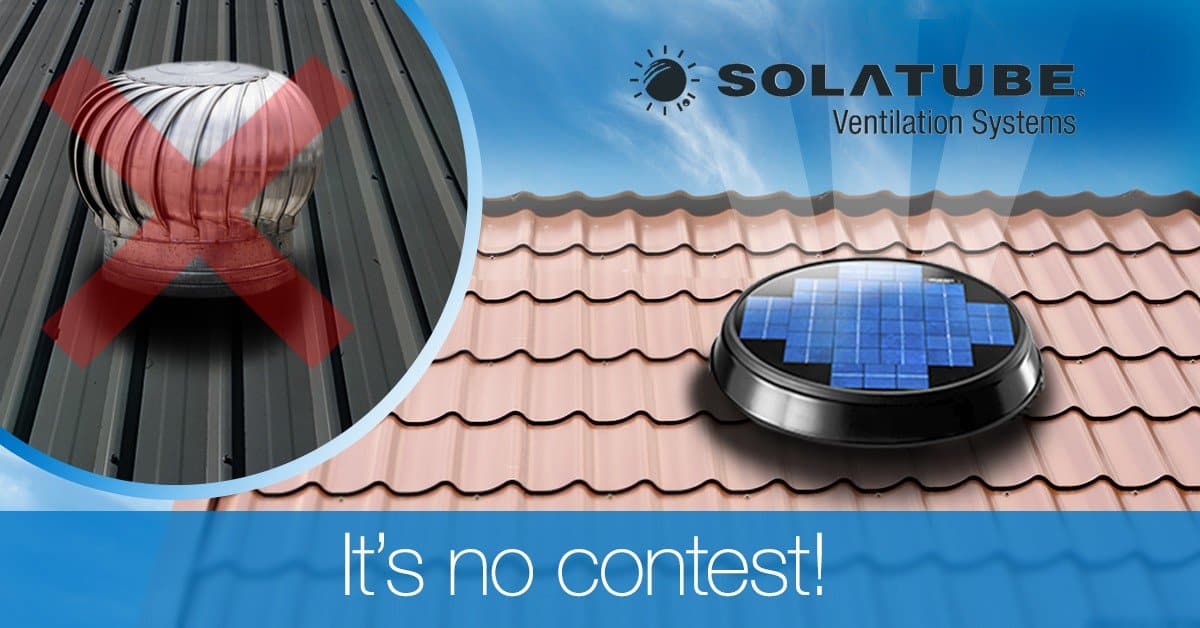
House like a furnace? Use the sun to cool it down!
Did you know that your home’s roof cavity can reach up to 70° Celsius on a hot summer’s day? That’s hot enough to fry an egg! And the worst thing is that it then heats the rest of your home. Solatube, Australia’s skylighting and roof ventilation specialist, has developed a solar-powered solution that will not only cool your roof cavity but also your home – helping keep energy costs down.
Solatube’s Solar Star is designed to remove excess heat from the roof cavity. It uses a high-efficiency fan unit powered entirely by solar panels, which means you get all the advantage of a powerful roof fan without the added operational costs. It’s also whisper quiet.
“A hot roof cavity is the leading cause of heating up your home,” explains Solatube’s Brett Dickson. “Not only that, it also hinders the effectiveness of ceiling fans and air conditioning. While your air conditioning is trying to cool the space, heat will still radiate from a roof cavity without adequate ventilation.
“A Solar Star removes hot, humid air from a roof’s cavity. The solar panels power an efficient motor that spins lightweight, low resistant, rust-proof fan blades. Hot air exits the roof cavity through a durable, integrated, rust-proof exhaust screen.
“It costs you nothing to operate and because the installation process is simple, the return on investment can be substantial. Not only will your home be cooler and drier, but the load on your air conditioning unit can also be significantly reduced. A cooler home means reduced reliance on electricity for fans or air conditioning use – and it saves you money.”
The brighter the sunlight, the faster the fan. In the summer, that means the roof cavity gets the most ventilation when it’s absorbing the most solar radiation — and that’s exactly what you want.
But Solar Star isn’t just for summer. It’s also ideal in the cooler months. It helps equalise interior and exterior temperatures and the solar fan reduces harmful moisture build-up to combat mould and mildew; it’s also less enticing for insects.
Residential developer Sekisui House has installed Solar Stars on its SHAWOOD homes at the master-planned community, The Hermitage in Gledswood Hills in Sydney’s South West.
“SHAWOOD homes by Sekisui House are aligned to several key performance elements – two of which are Thermal Comfort and Energy Efficiency. The Solar Star by Solatube is a neat fit for SHAWOOD, aligning to both of these elements from not only a functionality perspective, but also aesthetically, due to its sleek minimalistic design. Having Solar Star as a standard SHAWOOD specification for 12 months now, we are satisfied of its performance output and solid reliability.”
Reliability is a key factor for customers looking to purchase a quality roof ventilation system. “With many imports being shipped directly from overseas, consumers need to be careful selecting products for harsh environments such as Australia,” says Dickson. “A single, one-size-fits-all flashing creates similar issues with leaking as in traditional low-quality skylights. Consumers should always look for roof flashings that are tailored to the contours of their roof.”
Key features and benefits of the Solatube Solar Star:
- It’s powered by the sun, which means no operational costs. Advanced solar panel technology generates maximum power through a large 320 diameter fan
- It’s whisper quiet: you won’t hear it from inside or outside the home
- It has a sleek, low profile, and a seamless one-piece flashing guarantees a leak-proof and durable product. There are different flashing styles available that can be customised to your roof
- Installation is simple and straightforward: a certified Solatube installation consultant can do it in around an hour
- The Solar Star Thermal Switch will turn off the ventilation cycle when the temperature in your roof cavity is below 18°C, and start again when the temperature is over 29°C
- An add-on solar panel is an ideal addition when continuous sun exposure is limited
- Industry-leading 5-year warranty (no parts excluded)
Signs you may need roof ventilation in your home:
- Living spaces become hot and uncomfortable
- Air conditioning units work harder to keep rooms cool
- Utility costs rise due to increased energy demand
- Roof structures and materials deteriorate

